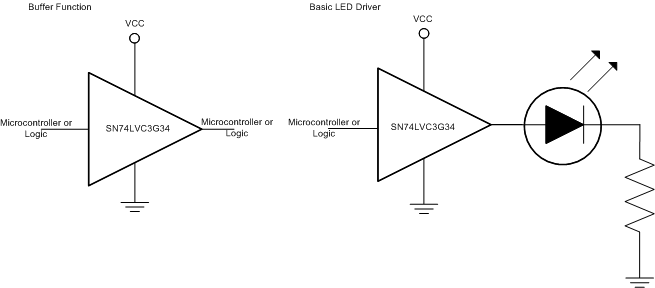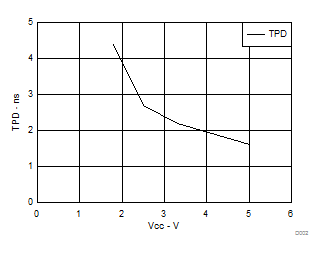SCES366L August 2001 – October 2015 SN74LVC3G34
PRODUCTION DATA.
- 1 Features
- 2 Applications
- 3 Description
- 4 Revision History
- 5 Pin Configuration and Functions
- 6 Specifications
- 7 Parameter Measurement Information
- 8 Detailed Description
- 9 Application and Implementation
- 10Power Supply Recommendations
- 11Layout
- 12Device and Documentation Support
- 13Mechanical, Packaging, and Orderable Information
封装选项
请参考 PDF 数据表获取器件具体的封装图。
机械数据 (封装 | 引脚)
- DCU|8
- YZP|8
- DCT|8
散热焊盘机械数据 (封装 | 引脚)
订购信息
9 Application and Implementation
9.1 Application Information
The SN74LVC3G34 is a high-drive CMOS device that can be used as a buffer with a high output drive, such as an LED application. It can produce 24 mA of drive current at 3.3 V, making it ideal for driving multiple outputs and good for high-speed applications up to 100 MHz. The inputs are 5.5-V tolerant, allowing it to translate down to VCC.
9.2 Typical Application

9.2.1 Design Requirements
This device uses CMOS technology and has balanced output drive. Take care to avoid bus contention because it can drive currents that would exceed maximum limits. The high drive will also create fast edges into light loads so routing and load conditions must be considered to prevent ringing.
9.2.2 Detailed Design Procedure
- Recommended Input Conditions
- Rise time and fall time specs. See (Δt/ΔV) in the Recommended Operating Conditions table.
- Specified high and low levels. See (VIH and VIL) in the Recommended Operating Conditions table.
- Inputs are overvoltage tolerant allowing them to go as high as (VI max) in the Recommended Operating Conditions table at any valid VCC.
- Recommended Output Conditions
- Load currents must not exceed (IO max) per output and must not exceed (Continuous current through VCC or GND) total current for the part. These limits are located in the Recommended Operating Conditions table.
- Outputs must not be pulled above VCC under normal operating conditions.
9.2.3 Application Curve
 Figure 3. TPD Across VCC at 25°C
Figure 3. TPD Across VCC at 25°C